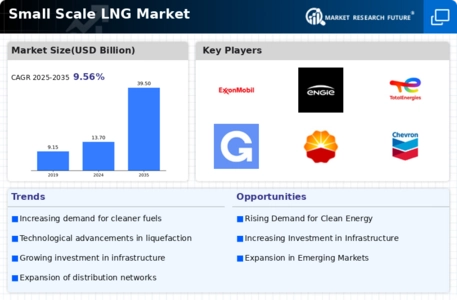Top Industry Leaders in the Small Scale LNG Market

*Disclaimer: List of key companies in no particular order
The small-scale LNG market, once a niche, is now a burgeoning domain presenting immense potential. Driven by increased demand for clean energy, challenges in remote accessibility, and environmental concerns, it attracts established entities and innovative startups alike. The competitive landscape is dynamically evolving, demanding meticulous attention from stakeholders eyeing this promising sector.
Strategies of Key Players:
Gazprom (Russia), Engie SA (France), Honeywell International Inc. (U.S.), Wärtsilä Corporation (Finland), The Linde Group (Germany), Skangas AS (Norway), IHI Corporation (Japan), Excelerate Energy L.P (U.S), Prometheus Energy (U.S), Cryostar (U.S.), GE Oil & Gas (U.S.), Novatek (Russia), among others are pivotal players.
-
Traditional Energy Giants: Shell, ExxonMobil, and TotalEnergies utilize existing infrastructure, focusing on modular liquefaction, strategic alliances, and technologies like mobile fuel dispensers for trucks and marine vessels. -
Emerging Technology Leaders: Companies like Clean Energy Fuels and Charbone Corporation innovate with cost-effective liquefaction and transport tech for off-grid power and remote industrial use. -
Regional Players: Sinopec (China) and GasLog (Greece) leverage regional knowledge, tailoring offerings for regional applications like fuel switching and LNG bunkering.
Market Share Evaluation Factors:
-
Technological Edge: Cutting-edge liquefaction, efficient transport, and robust infrastructure. -
Geographical Focus: Targeting high-demand regions with limited grid access. -
Application Expertise: Tailoring solutions for power, transportation, and industrial needs. -
Cost Competitiveness: Competitive pricing and flexible financing options. -
Partnerships: Collaborating with tech, logistics, and fuel distributors for expanded capabilities.
Emerging Trends:
-
Renewable LNG (RNG): Utilizing biogas and biomethane for sustainability and decarbonization goals. -
Digital Integration: Leveraging analytics, blockchain, and cloud for optimized logistics and transparent transactions. -
Modularization: Standardized, easily deployable equipment for accessibility and cost-effectiveness. -
Diverse Applications: Exploring LNG in mining, agriculture, and decentralized microgrids for market expansion.
Competitive Scenario:
-
Intense Competition: Established players vie with startups; agility is crucial for traditional giants. -
Technological Advancements: Tech, regional demands, and new applications shape the landscape. -
Strategic Adaptability: Understanding client needs, R&D, and partnerships are key for market capture.
The small-scale LNG market promises opportunities for established entities and newcomers. Analyzing strategies, market drivers, and emerging trends aids strategic navigation of this dynamic landscape. Stakeholders can capitalize on this promising future by staying abreast of these developments.
Latest Industry Updates:
- Gazprom and Shell sign MoU for European small-scale LNG projects.
- Engie and Geodis launch joint venture for small-scale LNG bunkering in France.
- Honeywell unveils new cryogenic pump technology for small-scale LNG applications.
- Wärtsilä delivers 50 MW dual-fuel engine for a small-scale LNG power plant in Indonesia.
- Skangas AS commissioned the world's first LNG bunkering vessel in 2015, leading in the Scandinavian market.
- IHI Corporation pioneers various small-scale LNG technologies, including carriers and regasification terminals.

